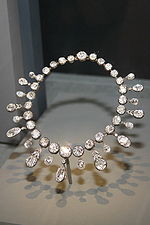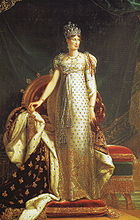
Napoleon Diamond Necklace
Encyclopedia

Diamond
In mineralogy, diamond is an allotrope of carbon, where the carbon atoms are arranged in a variation of the face-centered cubic crystal structure called a diamond lattice. Diamond is less stable than graphite, but the conversion rate from diamond to graphite is negligible at ambient conditions...
necklace
Necklace
A necklace is an article of jewellery which is worn around the neck. Necklaces are frequently formed from a metal jewellery chain. Others are woven or manufactured from cloth using string or twine....
commissioned by Napoleon I of France
Napoleon I of France
Napoleon Bonaparte was a French military and political leader during the latter stages of the French Revolution.As Napoleon I, he was Emperor of the French from 1804 to 1815...
c. 1811–1812. It is currently on display in the Smithsonian Institution
Smithsonian Institution
The Smithsonian Institution is an educational and research institute and associated museum complex, administered and funded by the government of the United States and by funds from its endowment, contributions, and profits from its retail operations, concessions, licensing activities, and magazines...
in Washington, D.C.
Washington, D.C.
Washington, D.C., formally the District of Columbia and commonly referred to as Washington, "the District", or simply D.C., is the capital of the United States. On July 16, 1790, the United States Congress approved the creation of a permanent national capital as permitted by the U.S. Constitution....
, United States
United States
The United States of America is a federal constitutional republic comprising fifty states and a federal district...
.
Description
The Napoleon Diamond Necklace consists of 28 mine cut diamonds set into a single thread, with a fringe of alternating pendeloque and briolettes diamond cutDiamond cut
A diamond cut is a style or design guide used when shaping a diamond for polishing such as the brilliant cut. Cut does not refer to shape , but the symmetry, proportioning and polish of a diamond...
s. The five pear-shaped pendoloques are each mounted below a small brilliant cut diamond. The four ovaline pendeloques are mounted above designs which incorporate 23 brilliant cut diamonds each. Each briolette mounting is set with 12 rose cut diamonds.
While the gems of the Napoleon Diamond Necklace have never been professionally graded by a lapidary
Lapidary
A lapidary is an artist or artisan who forms stone, mineral, gemstones, and other suitably durable materials into decorative items such as engraved gems, including cameos, or cabochons, and faceted designs...
(as they have never been removed from their mountings), infrared spectroscopic
Infrared spectroscopy
Infrared spectroscopy is the spectroscopy that deals with the infrared region of the electromagnetic spectrum, that is light with a longer wavelength and lower frequency than visible light. It covers a range of techniques, mostly based on absorption spectroscopy. As with all spectroscopic...
analysis of the diamonds has shown that they are primarily Type Ia. However, 13 of the 52 largest diamonds in the necklace are of the rare Type IIa variety. A number of the Type Ia diamonds show indications of sulfide
Sulfide
A sulfide is an anion of sulfur in its lowest oxidation state of 2-. Sulfide is also a slightly archaic term for thioethers, a common type of organosulfur compound that are well known for their bad odors.- Properties :...
crystal imperfections.
Marie Louise

Napoleon I of France
Napoleon Bonaparte was a French military and political leader during the latter stages of the French Revolution.As Napoleon I, he was Emperor of the French from 1804 to 1815...
divorced the Empress Joséphine
Joséphine de Beauharnais
Joséphine de Beauharnais was the first wife of Napoléon Bonaparte, and thus the first Empress of the French. Her first husband Alexandre de Beauharnais had been guillotined during the Reign of Terror, and she had been imprisoned in the Carmes prison until her release five days after Alexandre's...
, as she proved to be incapable of producing an heir. He re-married two months later to Archduchess Marie Louise of Austria
Marie Louise, Duchess of Parma
Marie Louise of Austria was the second wife of Napoleon I, Emperor of the French and later Duchess of Parma...
. Within a year, Marie Louise bore a son
Napoleon II of France
Napoléon II , after 1818 known as Franz, Duke of Reichstadt, was the son of Napoleon I, Emperor of the French, and his second wife, Marie Louise of Austria...
. To celebrate, in June 1811 Napoleon I commissioned the Napoleon Diamond Necklace from the Paris
Paris
Paris is the capital and largest city in France, situated on the river Seine, in northern France, at the heart of the Île-de-France region...
ian jewellery firm Nitot et Fils, at a cost of 376,274 French franc
French franc
The franc was a currency of France. Along with the Spanish peseta, it was also a de facto currency used in Andorra . Between 1360 and 1641, it was the name of coins worth 1 livre tournois and it remained in common parlance as a term for this amount of money...
s. This sum was the equivalent of the Empress's entire annual household budget. There are several contemporary portraits of Marie Louise wearing the Napoleon Diamond Necklace, including a number by the artists François Gérard
François Gerard
François Pascal Simon, Baron Gérard was a French painter born in Rome, where his father occupied a post in the house of the French ambassador. His mother was Italian. As a baron of the Empire he is sometimes referred to as Baron Gérard.-Life:François Gérard was born in Rome, on 12 March 1770, to...
and Giovan Battista Borghesi. Several years later, in 1815, Napoleon was exiled to Saint Helena
Saint Helena
Saint Helena , named after St Helena of Constantinople, is an island of volcanic origin in the South Atlantic Ocean. It is part of the British overseas territory of Saint Helena, Ascension and Tristan da Cunha which also includes Ascension Island and the islands of Tristan da Cunha...
. Marie Louise returned to Austria with the necklace, and owned it until her death.
Inheritance and sales
Upon the death of Marie Louise in 1847, the necklace passed to Archduchess Sophie of AustriaPrincess Sophie of Bavaria
Sophie Friederike Dorothee Wilhelmine, Princess of Bavaria was born to King Maximilian I Joseph of Bavaria and his second wife Karoline of Baden. She was the identical twin sister of Princess Maria Anna of Bavaria, Queen of Saxony as wife of Frederick Augustus II of Saxony...
, the wife of her nephew Archduke Franz Karl of Austria
Archduke Franz Karl of Austria
Archduke Franz Karl Joseph of Austria from the House of Habsburg was father of two emperors as well as the grandfather of Archduke Franz Ferdinand of Austria, whose assassination sparked the hostilities that led to the outbreak of World War I, and the greatgrandfather of the last Habsburg...
. Two diamonds were removed from the necklace to shorten it, at the request of Princess Sophie. These diamonds were fitted to a pair of earrings, the location of which is now unknown. Following the death of Sophie in 1872, the Napoleon Diamond Necklace was jointly inherited by her three surviving sons, Archdukes Karl Ludwig, Ludwig Viktor
Archduke Ludwig Viktor of Austria
Archduke Ludwig Viktor of Austria from the House of Habsburg was the youngest son born to Archduke Franz Karl of Austria and Princess Sophie of Bavaria...
, and Franz Joseph
Franz Joseph I of Austria
Franz Joseph I or Francis Joseph I was Emperor of Austria, King of Bohemia, King of Croatia, Apostolic King of Hungary, King of Galicia and Lodomeria and Grand Duke of Cracow from 1848 until his death in 1916.In the December of 1848, Emperor Ferdinand I of Austria abdicated the throne as part of...
of Austria. Karl Ludwig later acquired his brothers' stakes in the necklace, and upon his death in 1914 passed it to his third wife, Maria Theresa of Portugal.
At the start of the Great Depression
Great Depression
The Great Depression was a severe worldwide economic depression in the decade preceding World War II. The timing of the Great Depression varied across nations, but in most countries it started in about 1929 and lasted until the late 1930s or early 1940s...
in 1929, Maria Theresa engaged two people presenting themselves as "Colonel Townsend" and "Princess Baronti" to sell the necklace for US$
United States dollar
The United States dollar , also referred to as the American dollar, is the official currency of the United States of America. It is divided into 100 smaller units called cents or pennies....
450,000. Realising that the current economic conditions would make it almost impossible to reach the asking price, the pair began offers at $100,000, signing on Archduke Leopold of Habsburg, the destitute grandnephew of Maria Theresa, to vouch for the necklace's authenticity. Deals were negotiated with the jewelers Harry Winston
Harry Winston
Harry Winston was an American jeweler. He donated the Hope Diamond to the Smithsonian Institution in 1958 after owning it for a decade, and traded the Portuguese Diamond to the Smithsonian in 1963.-History:...
and Harry Berenson, but eventually the pair sold the necklace to David Michel of New York
New York
New York is a state in the Northeastern region of the United States. It is the nation's third most populous state. New York is bordered by New Jersey and Pennsylvania to the south, and by Connecticut, Massachusetts and Vermont to the east...
for $60,000, of which the pair claimed $53,730 as expenses. When informed of the sale, Maria Theresa took the matter to court, eventually resulting in the recovery of the necklace, the jailing of Archduke Leopold, and the flight of Townsend and Baronti from the authorities.
After resolving the incident, Maria Theresa held the necklace until her death in 1944. Four years later, the Habsburg family sold it to the French industrialist Paul-Louis Weiller
Javal family
The Javal family originated in Alsace. They benefited from Napoleon I's policy of openness toward Jews, and in the nineteenth century experienced a remarkable ascent, with family members becoming prominent bankers, industrialists, physicians, public officials and artists...
. In 1960, Weiller sold the Napoleon Diamond Necklace to Harry Winston, who believed that the historical value of the piece would make it more valuable than if the stones were removed and resold individually, as was common practice at the time. As such, he kept it intact, reselling it the same year to Marjorie Merriweather Post
Marjorie Merriweather Post
-External links:******...
. Post donated the necklace to the Smithsonian Institution
Smithsonian Institution
The Smithsonian Institution is an educational and research institute and associated museum complex, administered and funded by the government of the United States and by funds from its endowment, contributions, and profits from its retail operations, concessions, licensing activities, and magazines...
in 1962, and it has since remained on display at the National Museum of Natural History
National Museum of Natural History
The National Museum of Natural History is a natural history museum administered by the Smithsonian Institution, located on the National Mall in Washington, D.C., United States. Admission is free and the museum is open 364 days a year....
in Washington, D.C.
Washington, D.C.
Washington, D.C., formally the District of Columbia and commonly referred to as Washington, "the District", or simply D.C., is the capital of the United States. On July 16, 1790, the United States Congress approved the creation of a permanent national capital as permitted by the U.S. Constitution....
, United States
United States
The United States of America is a federal constitutional republic comprising fifty states and a federal district...
.

